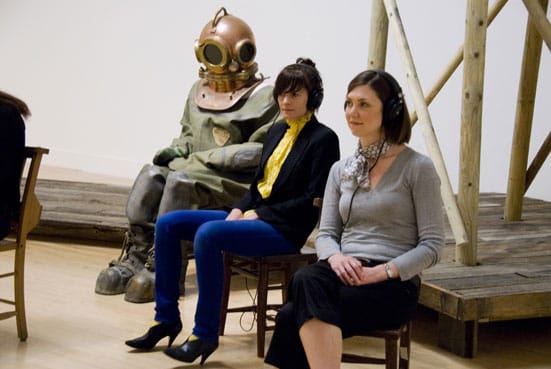30th June 2007 — 14th October 2007
An
archival tendency rings through the work of Goshka Macuga. Through the
meticulous trawling of collected documentation, found objects and art
works Macuga enters into previous moments in time to reveal the
individuals around which such moments gravitated. In 2003, she honed in
on the 19th century architect and collector Sir John Soane to recreate
his picture room (Gasworks, London). In 2006, the Theosophical Society
(1837-1907) and its co-founder Helena Blavatsky inspired her
installation The Sleep of Ulro (The A Foundation, Liverpool). For her
current Art Now exhibition, Objects in Relation, Macuga has delved into
the Tate Archive in order to focus in on Paul Nash and Unit One, a
cross-disciplinary group of architects, painters and sculptors founded
by Nash in 1933.
Upon entering the exhibition space the accompanying
explanatory text indicates that 'collage is an integral tool in
Macuga's practice'. Indeed, the space itself reads as one enlarged
collage, into which the viewer enters. Upon entry, the near left corner
features a Yew trunk, holding, within a cutaway, a photograph and
sketchbook. This assemblage stands abreast of an intaglio print,
lithograph and facsimile letter and downstage from a diving platform
and Russian diving suit. The breadth of materials used within this
exhibition is compelling and ambitious. Within Tate Britain's compact
Art Now space, Macuga endeavours to capture and represent something of
the essence that lead to the development of British Surrealism,
featuring work by Edward Burra, Barbara Hepworth, Henry Moore and
Edward Wadsworth. The 'List of Works', if looked over by the viewer,
proves to be an intriguing addition to this process of representation.
Itself, a tool for documentation, archiving Macuga's displaying of the
archive, the 'List of Works' is an amusing combination of the clearly
informative and the opaque. The works of other artists used within the
space are obligatorily attributed, followed by the brief biographical
detail of birth and death dates and Tate Archive numbers, while
additions to such works made by Macuga and other displayed found
objects are loosely classified as 'object', 'mixed media' or
'assemblage of ephemera'.
Macuga, the artist as personality, lies low throughout her own
exhibition, which admirably facilitates the revealing of the
individuals she has chosen to present. The 'Selection of Unit One
letters' is particularly successful in doing this. A staccato reading
of the formation and progression of Unit One is offered by a
cross-section of letters sent between the members of this group.
Interspersed around the exhibition space and interrupted by the other
objects that make up the exhibition a fragmentary yet endearing
narrative emerges. Draft handwritten letters spill over page margins
with text wrapping around the edges of a page. Re-drafted and typed-out
versions of the previous feature the occasional error or erased
section. These human traces on facsimiles suggest tensions,
complications, successes and urgencies. The viewer can mull over the
potential once contained in these letters, potential that was long ago
realised and is now re-configured in the deliberately incomplete
cross-section that Objects in Relation offers.
SJH
Tate Britain
Millbank
London SE1 9TG
http://www.tate.org.uk/britain/
Open
Daily, 10am-5.50pm

Goshka Macuga
Objects in Relation
Installation shot
Courtesy the artist and Kate McGarry
(c) Tate photography
Photo: Photocredit, Sam Drake